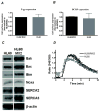Ethyl 2-amino-6-(3,5-dimethoxyphenyl)-4-(2-ethoxy-2-oxoethyl)-4H-chromene-3-carboxylate (CXL017): a novel scaffold that resensitizes multidrug resistant leukemia cells to chemotherapy
- PMID: 23102022
- PMCID: PMC3574219
- DOI: 10.1021/cb300460f
Ethyl 2-amino-6-(3,5-dimethoxyphenyl)-4-(2-ethoxy-2-oxoethyl)-4H-chromene-3-carboxylate (CXL017): a novel scaffold that resensitizes multidrug resistant leukemia cells to chemotherapy
Abstract
Multidrug resistance (MDR) is a major hurdle in the treatment of cancer, and there is a pressing need for new therapies. We have recently developed ethyl 2-amino-6-(3,5-dimethoxyphenyl)-4-(2-ethoxy-2-oxoethyl)-4H-chromene-3-carboxylate (CXL017), derived from a dual inhibitor of Bcl-2 and SERCA proteins, sHA 14-1, with selective cytotoxicity toward MDR cancer cell lines in vitro. In this study, we present new evidence for its therapeutic potential in treatment of MDR cancers and offer mechanistic insights toward its preferential targeting of drug-resistant cancer. CXL017 selectively suppressed the growth of tumors derived from the MDR cancer cell line, HL60/MX2, in vivo. In addition, even after chronic exposure to CXL017, HL60/MX2 failed to develop stable resistance to CXL017, whereas it acquired >2000-fold resistance to cytarabine (Ara-C), the major first-line chemotherapy for the treatment of acute myeloid leukemia (AML). Remarkably, instead of acquiring further cross-resistance, HL60/MX2 cells exposed to CXL017 were resensitized to standard therapies (10- to 100-fold). Western blotting analyses revealed that CXL017 exposure significantly down-regulated Mcl-1 and Bax and up-regulated Noxa, Bim, Bcl-X(L), SERCA2, and SERCA3 proteins, along with a reduction in endoplasmic reticulum (ER) calcium content. Given the well-established functions of Bcl-2 family proteins and ER calcium in drug resistance, our results suggest that the down-regulation of Mcl-1 and the up-regulation of Noxa and Bim along with the decrease in ER calcium content are likely responsible for CXL017-induced resensitization of MDR cancer cells. These data also demonstrate the unique potential of CXL017 to overcome MDR in cancer treatment.
Conflict of interest statement
The authors declare no competing financial interest.
Figures






Similar articles
-
A novel SERCA inhibitor demonstrates synergy with classic SERCA inhibitors and targets multidrug-resistant AML.Mol Pharm. 2013 Nov 4;10(11):4358-66. doi: 10.1021/mp400458u. Epub 2013 Sep 30. Mol Pharm. 2013. PMID: 24079514 Free PMC article.
-
Overexpression of Mcl-1 confers multidrug resistance, whereas topoisomerase IIβ downregulation introduces mitoxantrone-specific drug resistance in acute myeloid leukemia.Mol Pharmacol. 2013 Aug;84(2):236-43. doi: 10.1124/mol.113.086140. Epub 2013 May 21. Mol Pharmacol. 2013. PMID: 23696245 Free PMC article.
-
Structure-activity relationship and molecular mechanisms of ethyl 2-amino-6-(3,5-dimethoxyphenyl)-4-(2-ethoxy-2-oxoethyl)-4H-chromene-3-carboxylate (CXL017) and its analogues.J Med Chem. 2011 Aug 25;54(16):5937-48. doi: 10.1021/jm200764t. Epub 2011 Aug 3. J Med Chem. 2011. PMID: 21780800
-
Inhibitors of Chemoresistance Pathways in Combination with Ara-C to Overcome Multidrug Resistance in AML. A Mini Review.Int J Mol Sci. 2021 May 7;22(9):4955. doi: 10.3390/ijms22094955. Int J Mol Sci. 2021. PMID: 34066940 Free PMC article. Review.
-
Tumor microenvironment and epithelial mesenchymal transition as targets to overcome tumor multidrug resistance.Drug Resist Updat. 2020 Dec;53:100715. doi: 10.1016/j.drup.2020.100715. Epub 2020 Jun 20. Drug Resist Updat. 2020. PMID: 32679188 Review.
Cited by
-
Exploring the Structure-Activity Relationship and Mechanism of a Chromene Scaffold (CXL Series) for Its Selective Antiproliferative Activity toward Multidrug-Resistant Cancer Cells.J Med Chem. 2018 Aug 9;61(15):6892-6903. doi: 10.1021/acs.jmedchem.8b00813. Epub 2018 Jul 25. J Med Chem. 2018. PMID: 29995404 Free PMC article.
-
Targeting the Achilles heel of multidrug-resistant cancer by exploiting the fitness cost of resistance.Chem Rev. 2014 Jun 11;114(11):5753-74. doi: 10.1021/cr4006236. Epub 2014 Apr 23. Chem Rev. 2014. PMID: 24758331 Free PMC article. Review. No abstract available.
-
Chronic exposure to the gibberellin derivative GA-13315 sensitizes breast cancer MCF-7 cells but not colon cancer HCT116 cells to irinotecan.Oncol Lett. 2020 Dec;20(6):281. doi: 10.3892/ol.2020.12144. Epub 2020 Sep 23. Oncol Lett. 2020. PMID: 33014159 Free PMC article.
-
4H-Chromene-based anticancer agents towards multi-drug resistant HL60/MX2 human leukemia: SAR at the 4th and 6th positions.Bioorg Med Chem. 2016 Mar 15;24(6):1292-7. doi: 10.1016/j.bmc.2016.01.056. Epub 2016 Feb 1. Bioorg Med Chem. 2016. PMID: 26867486 Free PMC article.
-
A novel SERCA inhibitor demonstrates synergy with classic SERCA inhibitors and targets multidrug-resistant AML.Mol Pharm. 2013 Nov 4;10(11):4358-66. doi: 10.1021/mp400458u. Epub 2013 Sep 30. Mol Pharm. 2013. PMID: 24079514 Free PMC article.
References
-
- Nooter K, Sonneveld P. Clinical relevance of P-glycoprotein expression in haematological malignancies. Leuk Res. 1994;18:233–243. - PubMed
-
- Illmer T, Schuler US, Thiede C, Schwarz UI, Kim RB, Gotthard S, Freund D, Schakel U, Ehninger G, Schaich M. MDR1 gene polymorphisms affect therapy outcome in acute myeloid leukemia patients. Cancer Res. 2002;62:4955–4962. - PubMed
-
- Kim DH, Park JY, Sohn SK, Lee NY, Baek JH, Jeon SB, Kim JG, Suh JS, Do YR, Lee KB. Multidrug resistance-1 gene polymorphisms associated with treatment outcomes in de novo acute myeloid leukemia. Int J Cancer. 2006;118:2195–2201. - PubMed
-
- Xu YC, Lin YM, Zhang FC. The relationship between abnormal MDR gene expression and chemotherapy response in lymphoid malignancies. Zhonghua Zhong Liu Za Zhi. 2006;28:353–356. - PubMed
Publication types
MeSH terms
Substances
Grants and funding
LinkOut - more resources
Full Text Sources
Medical
Research Materials

